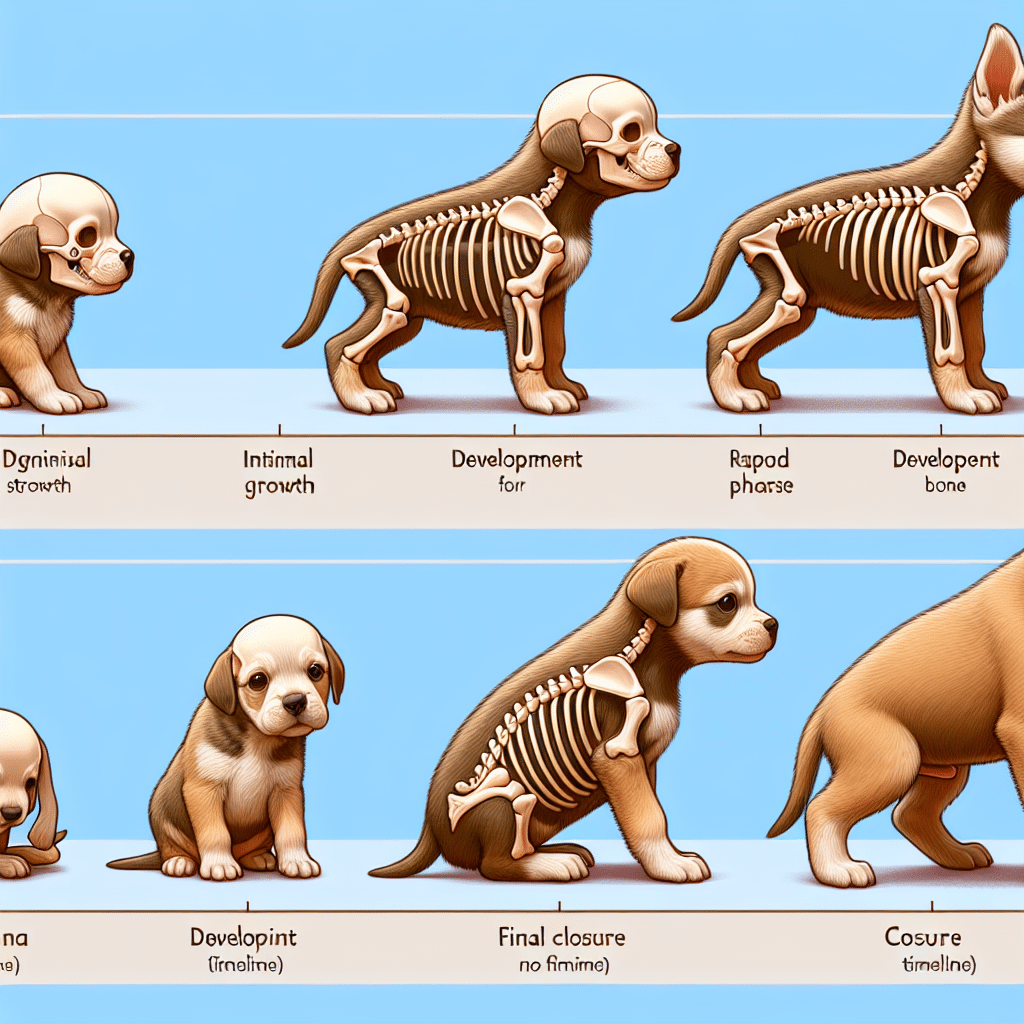Puppy growth plate development
Table of Contents
Puppy growth plate development is a critical aspect of canine physiology, involving the areas of cartilage located near the ends of long bones. These growth plates, or epiphyseal plates, are where new bone tissue is generated, allowing the bones to lengthen and the puppy to grow. This process is highly regulated and occurs in several stages, starting from the formation of cartilage cells, which then mature and are gradually replaced by bone cells. The growth plates remain active and open during the puppy’s developmental phase, typically closing and ossifying as the dog reaches maturity. Proper nutrition, exercise, and overall health are essential to ensure normal growth plate development and to prevent potential issues such as growth plate injuries or developmental disorders.
Understanding Puppy Growth Plate Development: Key Stages and Milestones
Understanding puppy growth plate development is crucial for ensuring the healthy growth and overall well-being of young dogs. Growth plates, also known as epiphyseal plates, are areas of developing cartilage tissue near the ends of long bones. These plates are essential for bone growth and development, as they allow bones to lengthen and mature properly. As puppies grow, these plates gradually ossify and transform into solid bone, marking the end of the growth phase. The process of growth plate development can be divided into several key stages and milestones, each of which plays a vital role in the overall growth and health of the puppy.
Initially, growth plates are composed of cartilage, a flexible and resilient tissue that provides a framework for new bone formation. During the early stages of a puppy’s life, these plates are highly active, facilitating rapid bone growth. This period is characterized by significant increases in height and length, as the bones elongate to accommodate the puppy’s developing body. It is during this time that proper nutrition and care are paramount, as any deficiencies or imbalances can adversely affect growth plate function and, consequently, bone development.
As the puppy continues to grow, the growth plates begin to undergo a process called ossification, where the cartilage is gradually replaced by bone tissue. This transition is critical, as it signifies the maturation of the bones and the eventual cessation of growth. The rate of ossification can vary depending on factors such as breed, size, and genetics. For instance, smaller breeds tend to reach full skeletal maturity faster than larger breeds, with growth plates closing as early as six to eight months of age. In contrast, larger breeds may continue to grow until they are 18 to 24 months old, with growth plates remaining open for a longer duration.
Throughout this developmental period, it is essential to monitor the puppy’s activity levels and physical exertion. Excessive exercise or high-impact activities can place undue stress on the growth plates, potentially leading to injuries or developmental issues. Conditions such as growth plate fractures or premature closure can result in abnormal bone growth, leading to deformities or long-term orthopedic problems. Therefore, it is advisable to provide age-appropriate exercise and avoid activities that may strain the developing bones and joints.
In addition to physical activity, proper nutrition plays a pivotal role in supporting healthy growth plate development. A balanced diet rich in essential nutrients, such as calcium, phosphorus, and vitamin D, is necessary for optimal bone health. Overfeeding or providing an imbalanced diet can lead to rapid growth, which may increase the risk of growth plate injuries. Consulting with a veterinarian to ensure that the puppy’s dietary needs are met is a prudent step in promoting healthy development.
As the puppy approaches skeletal maturity, the growth plates will eventually close, signifying the end of the growth phase. This closure marks a significant milestone, as the bones have reached their full length and the risk of growth plate-related injuries diminishes. However, it is important to continue providing proper care and nutrition to maintain overall bone health and prevent future orthopedic issues.
In conclusion, understanding the stages and milestones of puppy growth plate development is essential for fostering healthy growth and preventing potential complications. By providing appropriate nutrition, monitoring activity levels, and seeking veterinary guidance, pet owners can support their puppies through this critical developmental period, ensuring a strong foundation for a healthy and active life.
Common Issues in Puppy Growth Plate Development and How to Prevent Them

Puppy growth plate development is a critical aspect of their overall health and well-being. Growth plates, also known as epiphyseal plates, are areas of developing cartilage tissue near the ends of long bones. These plates are crucial for determining the future length and shape of the mature bone. However, several common issues can arise during this developmental phase, potentially leading to long-term complications if not addressed promptly. Understanding these issues and implementing preventive measures can significantly enhance a puppy’s growth trajectory and overall health.
One of the most prevalent issues in puppy growth plate development is premature closure. Growth plates are supposed to remain open until the puppy reaches skeletal maturity, which varies by breed but generally occurs between 12 to 18 months of age. Premature closure can result from trauma, over-exercise, or nutritional imbalances. When a growth plate closes too early, it can lead to uneven bone growth, causing deformities and potential mobility issues. To prevent premature closure, it is essential to manage a puppy’s activity levels carefully. Avoiding high-impact activities and ensuring that exercise is appropriate for the puppy’s age and breed can mitigate the risk of trauma to the growth plates.
Another common issue is growth plate fractures. Puppies are naturally curious and energetic, which sometimes leads to accidents and injuries. Growth plate fractures can occur from falls, rough play, or other forms of physical trauma. These fractures are particularly concerning because the growth plates are softer and more vulnerable than the surrounding bone. If a fracture occurs, it can disrupt normal bone development, leading to angular limb deformities or length discrepancies between limbs. Immediate veterinary attention is crucial if a growth plate fracture is suspected. Treatment often involves immobilization and, in severe cases, surgical intervention to ensure proper healing and alignment.
Nutritional imbalances also play a significant role in growth plate development issues. Puppies require a balanced diet rich in essential nutrients to support their rapid growth. Overfeeding or underfeeding can both have detrimental effects. Overfeeding, particularly with high-calorie diets, can lead to accelerated growth, putting undue stress on the growth plates and increasing the risk of developmental abnormalities. Conversely, underfeeding can result in malnutrition, hindering proper bone development. Consulting with a veterinarian to establish a balanced diet tailored to the puppy’s breed, size, and activity level is vital for preventing nutritional-related growth plate issues.
Genetic factors can also influence growth plate development. Certain breeds are predisposed to specific growth plate disorders. For instance, large and giant breeds are more susceptible to conditions like hip dysplasia and osteochondritis dissecans (OCD), which can affect the growth plates. Responsible breeding practices, including genetic screening and selecting breeding pairs with no history of growth plate disorders, can help reduce the incidence of these issues. Prospective puppy owners should research breed-specific risks and choose breeders who prioritize health and genetic soundness.
In conclusion, while growth plate development is a natural and essential process in a puppy’s growth, it is not without potential complications. Premature closure, fractures, nutritional imbalances, and genetic predispositions are common issues that can arise. However, with careful management of activity levels, prompt veterinary care for injuries, balanced nutrition, and responsible breeding practices, many of these issues can be prevented or mitigated. By taking proactive steps, puppy owners can help ensure their furry companions grow into healthy, well-developed adults.
Nutrition and Exercise Tips for Healthy Puppy Growth Plate Development
Ensuring the healthy development of a puppy’s growth plates is crucial for their overall well-being and future mobility. Growth plates, also known as epiphyseal plates, are areas of developing cartilage tissue near the ends of long bones. These plates are responsible for the longitudinal growth of bones during a puppy’s developmental stages. Proper nutrition and exercise play pivotal roles in supporting the healthy development of these growth plates, thereby preventing potential orthopedic issues later in life.
To begin with, nutrition is a fundamental aspect of promoting healthy growth plate development. Puppies require a balanced diet rich in essential nutrients, including proteins, fats, vitamins, and minerals. Proteins are particularly important as they provide the building blocks for muscle and bone growth. High-quality puppy food, specifically formulated to meet the nutritional needs of growing dogs, should be the primary source of these nutrients. It is advisable to consult with a veterinarian to determine the most appropriate diet for your puppy, taking into account their breed, size, and activity level.
In addition to proteins, calcium and phosphorus are critical minerals for bone development. However, it is essential to maintain a proper balance between these two minerals. Excessive calcium intake can lead to abnormal bone growth and skeletal deformities, while insufficient calcium can result in weak bones and increased susceptibility to fractures. Therefore, it is recommended to avoid supplementing your puppy’s diet with additional calcium unless specifically advised by a veterinarian.
Transitioning to the role of exercise, it is important to recognize that while physical activity is beneficial for overall health, excessive or inappropriate exercise can be detrimental to growth plate development. Puppies have delicate and developing bones that are more susceptible to injury. High-impact activities, such as jumping from heights or running on hard surfaces, can place undue stress on the growth plates, potentially leading to fractures or other orthopedic issues. Instead, controlled and moderate exercise is recommended to promote healthy bone development without causing harm.
Structured play sessions, short walks, and gentle activities like swimming are excellent ways to provide exercise for your puppy. These activities help in building muscle strength and coordination while minimizing the risk of injury. It is also important to allow your puppy ample time for rest and recovery, as excessive fatigue can negatively impact their growth and development.
Furthermore, monitoring your puppy’s weight is crucial in preventing undue stress on their growth plates. Overweight puppies are at a higher risk of developing orthopedic problems due to the increased load on their developing bones. Regular veterinary check-ups can help ensure that your puppy maintains a healthy weight and receives appropriate guidance on diet and exercise.
In conclusion, the healthy development of a puppy’s growth plates is a multifaceted process that requires careful attention to both nutrition and exercise. Providing a balanced diet rich in essential nutrients, maintaining a proper calcium-phosphorus balance, and engaging in controlled physical activities are key strategies to support optimal growth plate development. By following these guidelines and seeking regular veterinary advice, you can help ensure that your puppy grows into a healthy and active adult dog, free from orthopedic complications.┬Ā





![The Dog Podcast Uncovers Startling Truths About What We Feed Our Dogs [Press Release]](https://storyforge.com.au/wp-content/uploads/2024/08/dogfood-400x280.jpg)


